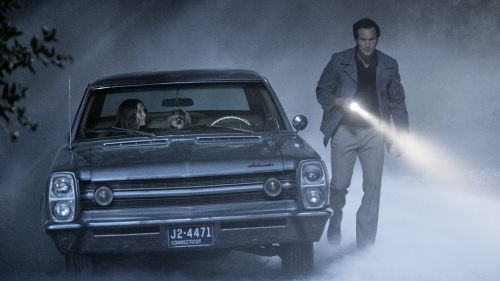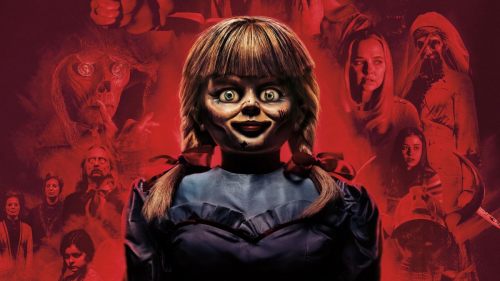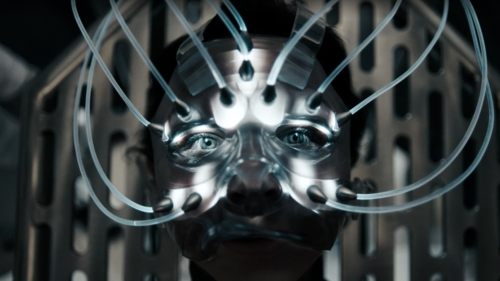On ANNABELLE And Talky Tina: A Brief History Of Horror’s Dolls
With Annabelle: Creation seizing the number one spot at the box office last weekend, it got me thinking about the ultimate classic horror doll, Talky Tina. Yes, before the Conjuring prequel had us sprinkling holy water on our baby dolls, before Chucky terrorized audiences in Child’s Play (1988), and before that crazy clown doll from Poltergeist (1982) dragged Robbie Freeling under his own bed, there was a similarly innocuous doll that taunted and killed a disgruntled stepdad in season one of Rod Serling’s iconic sci-fi series The Twilight Zone.
I couldn’t help but think of Talky Tina when I was watching Annabelle: Creation, which takes us back to the origin tale of the so-called possessed doll that later became the source of evil in the first Conjuring film. It compelled me to watch the 1963 episode titled “Living Doll,” about a young girl named Christie (Tracy Stratford) who was just gifted a new doll that can talk. She’s so excited to come home and show it off to her stepdad (Telly Savalas), who couldn’t be less impressed about the fact that his wife’s (Mary LaRoche) daughter now has an annoying new toy. (His wife’s name, by the way, is Annabelle). He doesn’t pay the doll any attention at first, until it somehow senses his coldness toward Christie and begins threatening him. You see, the genre has long explored the concept of dolls, designed to comfort and be a companion to their young owners. In fact, Hollywood has spent years casting a dark shadow on these childhood symbols, making us all to want to tuck them away in the back of our closets at night.
But still, these toys have the children’s best interests in mind, despite the often formidable outcome. Serling said it best at the end of “Living Doll”: “To a child caught in the middle of turmoil and conflict, a doll can become many things: friend, defender, guardian.” I think about this in terms of Annabelle: Creation. The original owner of the doll is Bee Mullins (Samara Lee), a young girl and only child of modest, church-going couple Mr. and Mrs. Mullins (Anthony LaPaglia and Miranda Otto). She goes everywhere with Annabelle, handcrafted by her doll maker dad. And for a while, she is protected. That is, until she abandons Annabelle for one fateful moment, at the same time her life abruptly ends. After that, Annabelle is haunted by the evil spirit of Bee’s ghost, preying on the vulnerabilities of her grieving parents and everyone else on whom she can unleash her wrath.
Talky Tina is just as spiteful, instantly absorbing Erich’s (Savalas) disdain for it (which from here on out will be referred to as she/her, for reasons that better illuminate her actions) and plots his demise. She literally tells him that she will kill him, which drives him crazy. He tries to throw her away and she resurfaces in Christie’s bed that night. He even tries to tear her apart with some tools he has in his garage. She goes missing for a short while, but turns up later to his shock and bewilderment. How many times has Annabelle from the Conjuring/Annabelle films been thrown in a well with the lid tightly closed or locked away in a closet? How many times has Chucky been blown up, set on fire, and torn to pieces? They’re like Michael Myers and Jason Voorhees. These dolls, villains along the same ranks as the aforementioned ‘70s/’80s prototypes, can’t actually be killed (or stopped) because it’s our fears that intensify their power, that feeds their existence. Feelings of loneliness (Child’s Play), resentment (Living Doll), and companionship (Annabelle: Creation) are at the center of each of these stories. They pray on that.
And yet, the children are so protective of them. Christie even starts crying when Erich snatches the doll from her bed. She doesn’t want anything to happen to her dolly. She adores her, and Talky Tina adores her back and gives her everything she needs right now as she’s stuck in the middle of a loveless relationship between her mother and stepdad. The relationship between the doll and the young girl it often accompanies in horror defies adults’ understanding, because the doll is designed for the child's best interests, not the adult’s.The adult never understands the power of the doll until it’s got their life in its hands.
This brings us back to The Twilight Zone. “Living Doll” wasn't the only episode that explored the effect dolls have. There are two ventriloquist narratives that highlight the desperation and duplicity of man. “The Dummy” (1962) delves into man’s fear of his own self. We all know dummies aren't real, right? RIGHT? Well, Jerry Etherson (Cliff Robertson) was convinced his dummy was evil, so he smashes him in a trunk and thinks he’s in the clear. He even moves on and buys a new dummy for his act. But of course his first dummy, Willie, is not really gone and they are fatefully bonded together forever. And in the 1964 episode “Caesar and Me,” a ventriloquist named Jonathan (Jackie Cooper) falls on hard times and is told by his evil dummy that they should become robbers. He agrees to do so and they are successful, until the cops are tipped off and aim to arrest them both. It is then when Jonathan realizes that he is all alone; Caesar has reverted back to being a plain ole dummy and Jonathan is the only one being carted off to jail.
This dichotomy between the young girl protagonists and the adult male protagonists is an intriguing one, which further highlights how we all perceive dolls, what they mean to us and how they represent a part of ourselves—for better or for worse. Whether it’s the case of Annabelle: Creation or Talky Tina, or even Willie the dummy, Hollywood has tapped into our deepest vulnerabilities in the most innocent yet most frightening way.



